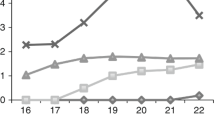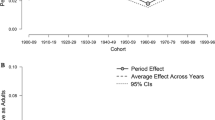Abstract
The emergence of partnered sexual behavior represents an important developmental transition. However, little is known about individuals who remain sexually inexperienced well into adulthood. We used data from 2,857 individuals who participated in Waves I–IV of the National Longitudinal Study of Adolescent Health (Add Health) and reported no sexual activity (i.e., oral-genital, vaginal, or anal sex) by age 18 to identify, using discrete-time survival models, adolescent sociodemographic, biosocial, and behavioral characteristics that predicted adult sexual inexperience. The mean age of participants at Wave IV was 28.5 years (SD = 1.92). Over one out of eight participants who did not initiate sexual activity during adolescence remained abstinent as young adults. Sexual non-attraction significantly predicted sexual inexperience among both males (aOR = 0.5) and females (aOR = 0.6). Males also had lower odds of initiating sexual activity after age 18 if they were non-Hispanic Asian, reported later than average pubertal development, or were rated as physically unattractive (aORs = 0.6–0.7). Females who were overweight, had lower cognitive performance, or reported frequent religious attendance had lower odds of sexual experience (aORs = 0.7–0.8) while those who were rated by the interviewers as very attractive or whose parents had lower educational attainment had higher odds of sexual experience (aORs = 1.4–1.8). Our findings underscore the heterogeneity of this unique population and suggest that there are a number of different pathways that may lead to either voluntary or involuntary adult sexual inexperience. Understanding the meaning of sexual inexperience in young adulthood may have important implications for the study of sexuality development across the life course.

Similar content being viewed by others
Notes
Fifty-one participants who reported none of these sexual experiences but reported a marriage partner with a valid marriage date were coded as sexually experienced, with their age at marriage used as their age at first sexual experience. The vast majority of these participants showed patterns of responses (e.g., history of pregnancy or sexually transmitted infection) that indicated past sexual experience.
References
Adamcyzk, A. (2009). Socialization and selection in the link between friends’ religiosity and the transition to sexual intercourse. Sociology of Religion, 70, 5–27.
Allison, P. D. (1982). Discrete-time methods for the analysis of event histories. In S. Leinhardt (Ed.), Sociological methodology (pp. 61–98). San Francisco: Jossey-Bass.
Biehl, M. C., Natsuaki, M. N., & Ge, X. (2007). The influence of pubertal timing on alcohol use and heavy drinking trajectories. Journal of Youth and Adolescence, 36, 153–167.
Billy, J. O., Tanfer, K., Grady, W. R., & Klepinger, D. H. (1993). The sexual behavior of men in the United States. Family Planning Perspectives, 25, 52–60.
Bogaert, A. F. (2004). Asexuality: Prevalence and associated factors in a national probability sample. Journal of Sex Research, 41, 279–287.
Brooks-Gunn, J., & Paikoff, R. (1997). Sexuality and developmental transitions during adolescence. In J. Schulenberg, J. L. Maggs, K. Hurrelmann, & L. Chassin (Eds.), Health risks and developmental transitions during adolescence (pp. 190–219). Cambridge: Cambridge University Press.
Brotto, L. A., Knudsen, G., Inskip, J., Rhodes, K., & Erskine, Y. (2010). Asexuality: A mixed-methods approach. Archives of Sexual Behavior, 39, 599–618.
Centers for Disease Control, Prevention. (2010). Youth Risk Behavior Surveillance—United States, 2009. Surveillance Summaries. Morbidity and Mortality Weekly Report, 59, 1–142.
Chassin, C. D. (2011). Theoretical issues in the study of asexuality. Archives of Sexual Behavior, 40, 713–723.
Cheng, M. M., & Udry, J. R. (2005). Sexual experiences of adolescents with low cognitive abilities in the US. Journal of Developmental and Physical Disabilities, 17, 155–172.
Donnelly, D., Burgess, E., Anderson, S., Davis, R., & Dillard, J. (2001). Involuntary celibacy: A life course analysis. Journal of Sex Research, 38, 159–169.
Dunn, L. M. (1981). Peabody Picture Vocabulary Test-revised: Manual for Forms L and M. Circle Pines, NM: American Guidance Service.
Eisenberg, M. L., Shindel, A. W., Smith, J. F., Lue, T. F., & Walsh, T. J. (2009). Who is the 40-year-old virgin and where did he/she come from? Data from the National Survey of Family Growth. Journal of Sexual Medicine, 6, 2154–2161.
Elder, G. H. (1998). The life course as developmental theory. Child Development, 69, 1–12.
Finer, L. B. (2007). Trends in premarital sex in the United States, 1954–2003. Public Health Reports, 122, 73–78.
Graber, J. A., Seeley, J. R., Brooks-Gunn, J., & Lewinsohn, P. M. (2004). Is pubertal timing associated with psychopathology in young adulthood? Journal of the American Academy of Child and Adolescent Psychiatry, 43, 718–726.
Halpern, C. T. (2005). Body mass index, dieting, romance, and sexual activity in adolescent girls: Relationships over time. Journal of Research on Adolescence, 15, 535–559.
Halpern, C. T., & Haydon, A. A. (2012). Sexual timetables for oral-genital, vaginal, and anal sex: Sociodemographic comparisons in a nationally representative sample. American Journal of Public Health, 102, 1221–1228.
Halpern, C. T., Waller, M. W., Spriggs, A., & Hallfors, D. D. (2006). Adolescent predictors of emerging adult sexual patterns. Journal of Adolescent Health, 39, 926.e1–926.e10.
Halpern-Felsher, B. L., Cornell, J. L., Kropp, R. Y., & Tschann, J. M. (2005). Oral versus vaginal sex among adolescents: Perceptions, attitudes, and behavior. Pediatrics, 115, 845–851.
Harris, K. M., Halpern, C. T., Whitsel, E., Hussey, J., Tabor, J., Entzel, P., & Udry, J. R. (2009). The National Longitudinal Study of Adolescent Health: Research design. Retrieved from http://www.cpc.unc.edu/projects/addhealth/design.
Haydon, A. A., McRee, A. L., & Halpern, C. T. (2011). Unwanted sex among young adults in the United States: The role of physical disability and cognitive performance. Journal of Interpersonal Violence, 26, 3476–3493.
Huber, P. J. (1967). The behavior of maximum likelihood estimates under nonstandard conditions. In Proceedings of the fifth Berkeley symposium on mathematical statistics and probability (Vol. 1, pp. 221–233). Berkeley, CA: University of California Press.
Kamen, P. (2000). Her way: Young women remake the sexual revolution. New York: New York University Press.
Lindberg, L. D., Jones, R., & Santelli, J. S. (2008). Noncoital sexual activities among adolescents. Journal of Adolescent Health, 43, 231–238.
Meier, A., & Allen, G. (2009). Romantic relationships from adolescence to young adulthood: Evidence from the National Longitudinal Study of Adolescent Health. Sociological Quarterly, 50, 308–335.
Mosher, W. D., Chandra, A., & Jones, J. (2005). Sexual behavior and selected health measures: Men and women 15–44 years of age, United States, 2002. Advance Data, 362, 1–55.
Ogden, C. L., Flegal, K. M., Carroll, M. D., & Johnson, C. L. (2002). Prevalence and trends in overweight among children and adolescents, 1999–2000. Journal of the American Medical Association, 288, 1728–1732.
Regnerus, M. D. (2003). Moral communities and adolescent delinquency: Religious contexts and community. Sociological Quarterly, 44, 523–554.
Regnerus, M. D., & Uecker, J. E. (2011). Premarital sex in America. New York: Oxford University Press.
Rostosky, S. S., Wilcox, B. L., Wright, M. L. C., & Randall, B. A. (2004). The impact of religiosity on adolescent sexual behavior: A review of the evidence. Journal of Adolescent Research, 19, 677–697.
Smith, C. (2003). Theorizing religious effects among American adolescents. Journal for the Scientific Study of Religion, 42, 17–30.
Uecker, J. E., Angotti, N., & Regnerus, M. D. (2008). Going most of the way: “Technical virginity” among American adolescents. Social Science Research, 37, 1200–1215.
White, H. (1980). A heteroskedasticity-consistent covariance matrix estimator and a direct test for heteroskedasticity. Econometrica, 48, 817–830.
Zimmer-Gembeck, M. J., & Helfand, M. (2008). Ten years of longitudinal research on US adolescent sexual behavior: Developmental correlates of sexual intercourse, and the importance of age, gender and ethnic background. Developmental Review, 28, 153–224.
Acknowledgments
Effort by Drs. Haydon, Herring, and Halpern was supported by grant R01HD57046, awarded to Dr. Halpern of the Carolina Population Center at the University of North Carolina at Chapel Hill by the Eunice Kennedy Shriver National Institute of Child Health and Human Development. This research was also supported by grant 5 R24 HD050924, Carolina Population Center, awarded to the Carolina Population Center at the University of North Carolina at Chapel Hill by the Eunice Kennedy Shriver National Institute of Child Health and Human Development. This research uses data from Add Health, a program project directed by Kathleen Mullan Harris and designed by J. Richard Udry, Peter S. Bearman, and Kathleen Mullan Harris at the University of North Carolina at Chapel Hill, and funded by grant P01-HD31921 from the Eunice Kennedy Shriver National Institute of Child Health and Human Development, with cooperative funding from 23 other federal agencies and foundations. Special acknowledgment is due Ronald R. Rindfuss and Barbara Entwisle for assistance in the original design. Information on how to obtain the Add Health data files is available on the Add Health Web site (http://www.cpc.unc.edu/addhealth). No direct support was received from grant P01-HD31921 for this analysis. At the time this work was conducted, Drs. Haydon and McRee were doctoral students in the Department of Maternal and Child Health at the Gillings School of Global Public Health and Dr. Haydon was also a pre-doctoral trainee at the Carolina Population Center, both at the University of North Carolina at Chapel Hill.
Author information
Authors and Affiliations
Corresponding author
Rights and permissions
About this article
Cite this article
Haydon, A.A., Cheng, M.M., Herring, A.H. et al. Prevalence and Predictors of Sexual Inexperience in Adulthood. Arch Sex Behav 43, 221–230 (2014). https://doi.org/10.1007/s10508-013-0164-3
Received:
Revised:
Accepted:
Published:
Issue Date:
DOI: https://doi.org/10.1007/s10508-013-0164-3




